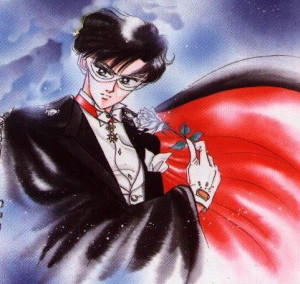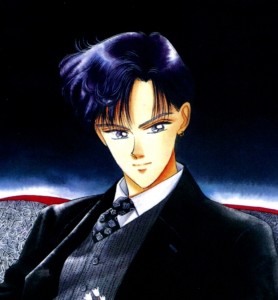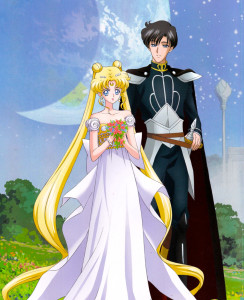Yes, it’s usually considered a bad thing to have a character whose sole purpose is to be the main character’s love interest and rescuer. But there are times when I’m perfectly fine with that because the character hits all my happy buttons.
Exhibit A: Tuxedo Mask/Chiba Mamoru/ Darien Shields/Prince Endymion from Pretty Soldier Sailor Moon
No, this isn’t four characters serving as an example of “I don’t care that they’re a sexy shadow puppet”. This is one character with multiple identities. In the original manga his name is Chiba Mamoru (for Americans that’s Mamoru Chiba) who fights for justice as Tuxedo Mask. In the American version of the anime series his name was changed to Darien Shields.
The character’s creator, Takeuchi Naoko, designed him to be her own ideal of a man: strong, silent, and enigmatic. He’s also a perfect gentleman. Clearly our similar taste in men is a sign that Ms. Takeuchi and I need to be friends.
Mrrow.
Tall, dark, and sexy as hell in a tuxedo (or a three piece suit), and always there when you need him. I’d like to know how much this hot buffet costs because I’m willing to sell organs to get in that line. I’ll also cut anyone who tries to line jump. Seriously. I have Black Friday skills.
(Deep breath…calm down. Time to wipe off the drool and get serious.)
His primary purpose in the series is to be Sailor Moon’s love interest and to rescue her from peril when her klutziness and fears get the best of her. It doesn’t get more Marty Stu than that. However, as the series progresses and we find out there’s much more to him then that. He’s a student, he knew and loved our fair protagonist in a past life, and oh yeah, he’s a freaking prince!
I love a man in uniform.
In a past life, back when all was well in the universe, he was Prince Endymion of Earth who wanted to marry Princess Serenity of the moon. Unfortunately we don’t often get to see him as Prince Endymion. Most of his royal appearances are in flash backs but when he does shift into prince form in the present it’s a jump to the edge of your seat, jump up and down and scream kind of moment because you know that some serious butt-kicking is about to go down.
Even though the infrequency of this glorious unveiling is disappointing I can’t complain. Most of his time on the page are as Mamoru and Tuxedo Mask. As I mentioned before, both forms are pretty yummy. It’s also great to see him swoop in and be awesome.
Except for that one time he became a creepy stalker.
At least he had the decency to remove his hat like a gentleman.
I kid, I kid. When put into context this scene isn’t nearly as creepy as it looks. He’s actually paying our fair protagonist a visit to give her a pep talk. She felt so inadequate at being a superhero that she decided to quit; and it was at a moment when her team needed her most. When Tuxedo mask found out he ran over to her place, jumped onto her window sill and proceeded to remind her of all the wonderful qualities and strengths that she possessed. You have to admit. There are times when we really really need that kind of rescuing….even when we didn’t know that the person doing the rescuing knew where we lived.
Yeah. So…
One of the things I respect Ms. Takeuchi for most is that instead of letting Mamoru be the white knight/love interest who just happens to have a day job of sorts, she gave him super powers of his own that equal what the heroines have. He has psychic powers (including psychometry) and healing abilities. Granted, we rarely see him use them in the manga, even more rarely in the animated series, and almost never in the live action show. (Can you tell I’m obsessed?) All right, it doesn’t sound that impressive when I put it that way. Keep in mind though that this series was created and intended for teenage girls. It’s all about girl power. Girls solve the problems, girls fight for justice and right wrongs, and on the occasion that they need a little help that’s when the guy steps in to lend a hand. So really, it’s because the heroines are so capable that Mamoru rarely gets the chance to use his powers. But my point still stands that the fact he even possesses special abilities and has a back story makes him a Marty Stu worth indulging in.
The Marty Stu haters can hate all they like. I firmly believe that every woman needs a pretend boyfriend to daydream about and Mamoru is mine. To be perfectly honest, Mamoru is the reason I got hooked into the show in the first place. I’ve never cared that he’s the prince of Mary Sues — literally. He’s everything I love in a man and since he’s fictitious I don’t have to worry about him leaving me for another woman…or another man. Besides, Marty Stus were never meant to be the ideal we should hold out for. They’re the ideal that we have little escapist fantasies about on a moonlit night when reality is too much…and there’s no shame in that.










